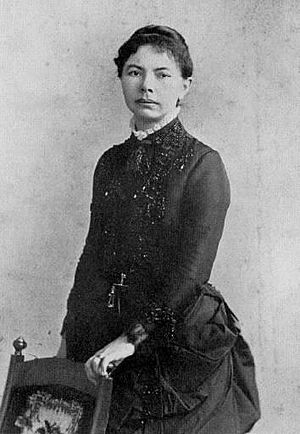Sarah Frances Whiting facts for kids
Quick facts for kids
Sarah Frances Whiting
|
|
|---|---|
 |
|
| Born | August 23, 1847 |
| Died | September 12, 1927 (aged 80) |
| Alma mater | Ingham University |
| Scientific career | |
| Fields | Astronomy |
| Institutions | Wellesley College |
| Notable students | Annie Jump Cannon Louise Sherwood McDowell |
Sarah Frances Whiting (born August 23, 1847 – died September 12, 1927) was an important American physicist and astronomer. She helped create the Whitin Observatory at Wellesley College and was its first leader. She taught many famous astronomers and physicists, including Annie Jump Cannon.
Contents
About Sarah Whiting
Sarah Whiting became interested in science at a young age. Her father taught her about natural philosophy, which was the study of how the world works. She finished her studies at Ingham University in 1865. After that, she taught at a school for girls in Brooklyn.
Teaching at Wellesley College
In 1876, one year after Wellesley College opened, its president, Henry Fowle Durant, hired Sarah Whiting. She became the college's first professor of physics. She started the physics department there. She also created an experimental physics lab for college students. This was only the second lab of its kind in the United States.
President Durant asked her to attend classes at the Massachusetts Institute of Technology (MIT). There, she learned from Edward Charles Pickering. Whiting watched how Pickering taught science using hands-on lab work. This way of teaching was new in the United States. Whiting used these ideas in her own classes. This made Wellesley College's physics lab the second one for college students in the country, after MIT's.
Pickering also invited Whiting to see new ways of studying astronomy, like spectroscopy. Spectroscopy is a method that helps scientists learn about stars by looking at the light they give off. In 1880, Whiting began teaching a class at Wellesley about practical astronomy.
X-ray Experiments
In February 1896, something very exciting happened. Just a few weeks after the discovery of x-rays was announced, Whiting did her own x-ray experiments with her students. She was one of the first people in the United States to successfully make x-rays. She was also likely the first woman to do so.
Annie Jump Cannon, who was one of Whiting's students and later a famous astronomer, shared a story about this time:
It was very exciting when the Boston newspapers reported the discovery of X-rays in 1895. The advanced physics students will always remember how quickly Miss Whiting set up an old Crookes tube. They were so happy when she took some of the first photos in this country. These photos showed coins inside a purse and bones inside a hand!
Besides Annie Jump Cannon, Mabel Augusta Chase and Grace Evangeline Davis also helped Whiting with her X-ray experiments.
Between 1896 and 1900, Whiting helped Sarah Elizabeth Whitin build the Whitin Observatory at Wellesley College. Whiting then became the first director of this observatory.
Later Life
In 1905, Tufts University gave Sarah Whiting an honorary doctorate degree. This is a special award that honors someone's achievements.
Whiting stopped being a physics professor at Wellesley in 1916. However, she continued to lead the Whitin Observatory until 1916. She was called a "Professor Emeritus" until she passed away in 1927. She is buried in Machpelah Cemetery in Le Roy, New York. This is near her old university, Ingham University, which no longer exists.
Her Writings
Sarah Whiting wrote a textbook called Daytime and evening exercises in astronomy, for schools and colleges.
She also wrote several articles for popular astronomy magazines. These articles included topics like:
- "Using Graphs to Teach Astronomy"
- "Using Drawings and Globes to Teach Astronomy"
- "Spectroscopic Work for Astronomy Classes"
- "Using Photographs to Teach Astronomy"
She also wrote about her experiences as a woman physicist in an article for the Wellesley College News.
Achievements and Honors
Honors
- 1883: Became a member of the American Association for the Advancement of Science (AAAS).
- 1905: Received an honorary doctorate from Tufts University.
Positions Held
- 1876–1912: Professor of Physics at Wellesley College.
- 1900–1916: Director of the Whitin Observatory at Wellesley College.
- 1916–1927: Professor Emeritus at Wellesley College (a special title for retired professors).
Education
- 1865: Earned her Bachelor of Arts (AB) degree from Ingham University.
See also
 In Spanish: Sarah Frances Whiting para niños
In Spanish: Sarah Frances Whiting para niños


